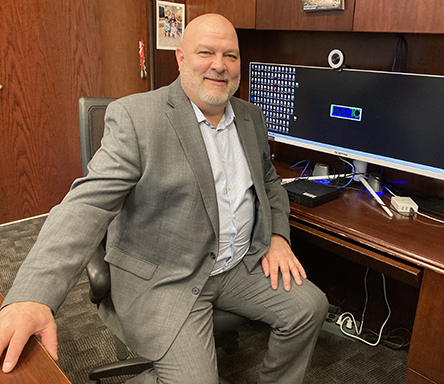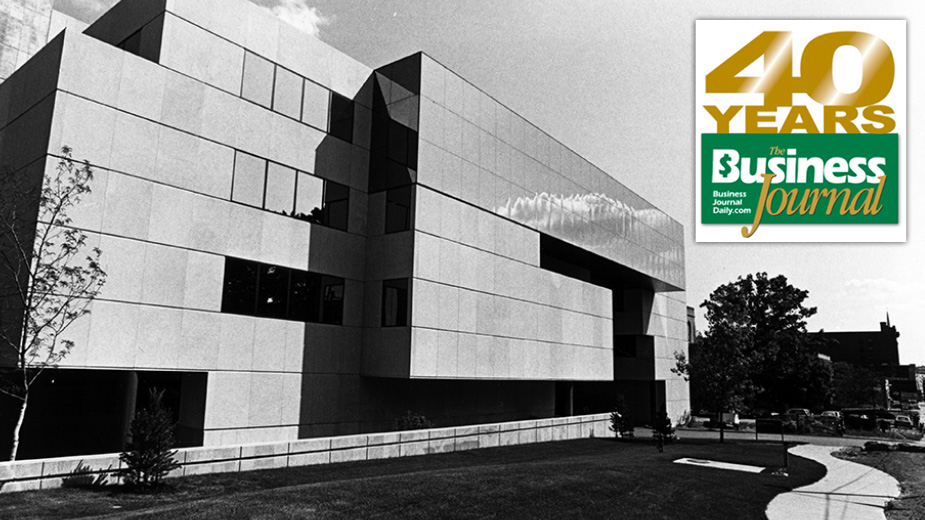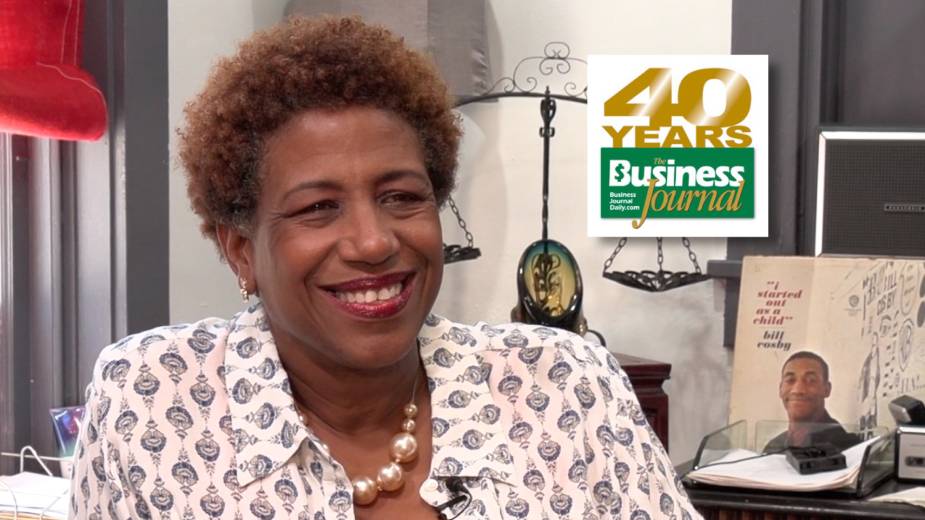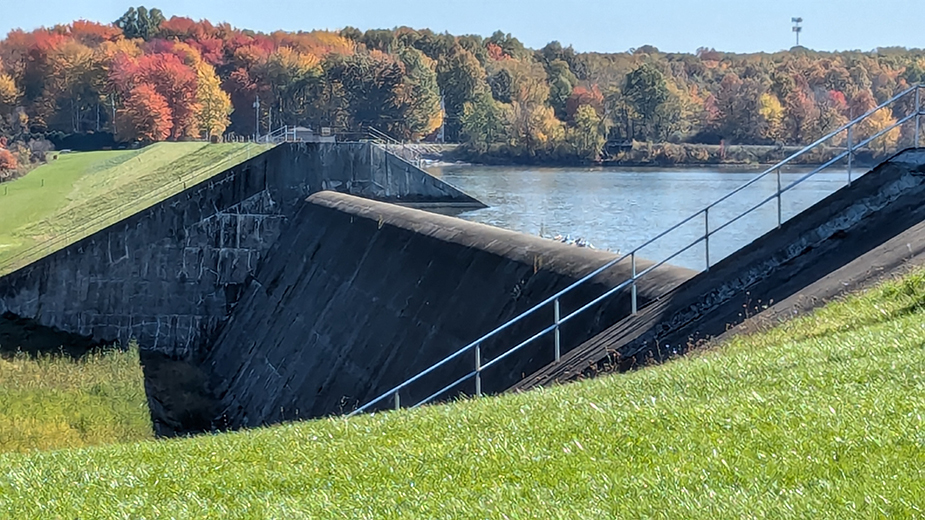Technology Changes Education, Career Choices
YOUNGSTOWN, Ohio – When Mahoning County Career and Technical Center Superintendent John Zehentbauer started as an instructor at the center in 1991, the equipment students used in classes lasted and remained industry-relevant for 20 years.
Now technology changes mean a much shorter useful life for equipment. And that’s just one of the changes across both K-12 and higher education over the last 40 years. Open enrollment and student debt weren’t major considerations then either. But they’re significant factors today.
Mahoning and Shenango Valley educators report shifts in focus, technological advances and new opportunities over the past four decades.
Technology
Manufacturing has come back to the Valley and that’s a good thing,” Zehentbauer says.
Technology has changed too.

“That evolution has been really something that intrigues me because technology in every program has increased,” Zehentbauer says.
Anthony Miller, director of the Mercer County Career and Technical Center, agrees.
“High-tech skills are part of the transition,” he says. “We have to make sure that all of our programs still meet the technology needs that are in that industry today. Those technology needs have gotten more advanced.”
That means equipment doesn’t last as long, Zehentbauer continues.
Technology changes so quickly. New equipment must be replaced more quickly. That’s expensive.
“The speed of technology has been the No. 1 challenge of education,” he says. “It did not used to be in my first 20 years.”
Jennifer A. Pintar, provost and vice president for academic affairs at Youngstown State University, points to technological advancements as well.
“The integration of technology into education has been one of the most significant changes,” she says in an email. “From the introduction of personal computers to the widespread use of the internet and now digital learning platforms and massive open online courses [MOOCs], technology has transformed how education is delivered and accessed.”
Artificial intelligence is a more recent example. “At YSU, we are exploring how we can make more of our programs accessible through fully online modalities,” Pintar says. YSU has also established a think tank “to develop active learning models and explore the ethical use of AI.”
YSU in the Past
In 1984, Neil D. Humphrey succeeded John Coffelt, becoming the fourth president of YSU. It’s the same year that James Ronda, a YSU history professor, was nominated for a Pulitzer Prize, construction of Meshel Hall was completed and at Ward Beecher Hall, a $12.7 million renovation project was underway to modernize its interior and exterior. Fall enrollment stood at 15,254 students.
Les Cochran served as YSU president from 1992 to 2000.
“The academic division had a higher percentage of accredited programs than any university in the state, including Ohio State,” Cochran says.
But costs were high.
“My first year on campus we had a $6 million deficit,” he says. Many of those costs Cochran attributes to a high number of staff. His administration trimmed that number without cutting faculty, he says.
“It was painful but we had to live within our means,” Cochran says.
Students were top of mind.
“We were committed to making and keeping YSU affordable because of the community and problems in the community,” the former president says.
He also points to how the costs of higher education have increased, resulting in more student loan debt.
“Trying to address these costs, the federal government increased Pell Grant funding by a whopping 1700%,” Cochran points out. “But because of the spiraling costs of higher education and the soaring number of students, the amount of the tab covered by these grants dropped from 72% to 34%.”
Tuition costs across the country have continued to rise.
“Universities did nothing to change; they plodded along like the proverbial dinosaur acting as if nothing had changed,” he says.
Cochran also believes universities spend too much on athletics.
He made athletics pay for its own scholarships. “Some people weren’t happy,” he says. “But the boosters rallied,” raising money through donations.
Addressing Challenges
David Sweet became YSU’s sixth president in 2000 and served for 10 years.
“As I assumed the position and was looking over challenges, I identified enrollment, diversity and partnerships,” Sweet says. “Those were the three areas I focused on.”
Enrollment grew from 11,000 to 15,000 during his tenure, diversity increased across faculty, staff and the student body and the university forged partnerships with the city including the Youngstown 2010 Plan and Youngstown CityScape.
Sweet’s tenure also saw the creation of new programs.
“We were the first institution in Ohio to have a STEM college,” Sweet says. “We put our science departments in with engineering to form the STEM college.”
Youngstown Early College High School was another first for Ohio universities. It allows Youngstown City School District high school students to take college classes on YSU’s campus and then easily enroll upon high school graduation.
“When I first arrived, students set up a meeting and gave me a petition to create a student recreation and wellness center,” Sweet says.
With approval from university trustees, they raised funding to build the Andrews Student Wellness and Recreation Center.
YSU built a new Williamson College of Business Administration building and created more student housing during Sweet’s time at the helm. The university marked its 100th anniversary, too.
“I’m very proud of most of what we did,” Sweet says.
In 2010, the YSU trustees selected Cynthia Anderson as the seventh YSU president. She was the first woman, first Mahoning Valley native and the first YSU graduate to serve in the role.
She served as president for three years but spent most of her career at YSU, rising through the ranks from instructor to associate professor, professor, associate provost and vice president of student affairs before being named to the top seat. During her tenure as president, Anderson trimmed $5 million from the operating budget, added programs and oversaw completion of the university’s strategic plan.
Randy Dunn followed as YSU’s eighth president, serving only seven months before leaving for the presidency of another university.
Jim Tressel became the ninth YSU president in 2014 after a campaign by community leaders who wanted him for the job. Tressel, a former national championship football coach at both YSU and Ohio State University, served nine years.
His tenure brought improvements to campus and the addition of several options for off-campus student housing. Tressel also improved the YSU graduation rates, increased the size of the honors college and raised $150 million through a capital campaign. But enrollment declines – experienced by colleges and universities across the country – led to program cuts.
Bill Johnson, a former U.S. congressman, became YSU’s 10th president in January.

Career Tech Perception
It was called the Mahoning County Joint Vocational Center when Zehentbauer joined the staff as an instructor in aircraft mechanics.
One big change is the perception that career tech, or formerly vocational technical education, is for students who aren’t college material. High school students were generally believed to fit into one of three categories: college preparatory, general education or vocational education.
“Flash forward to now, oh my gosh there are so many resources,” he says. “You’re getting the college prep kids here and you’re getting them early on. And they’re focused.”
Zehentbauer calls them “the well aware kids.” Their parents are open minded. And they’ve got a vision for their students.
If a student plans to be an engineer for example, one such parent knows that if the student enrolls at the career center, he’s going to be ahead because of the credentials and certifications available there, he says.
John Dilling, a consultant with the Columbiana County Educational Serv-ice Center, points to that change, too.
“In my time in vocational education, in my 21 years, [career technical] students weren’t thought of as gifted as those who stayed in their home school,” he says. “That perception has changed.”
Dilling started in education in 1972 as a teacher at United Local Schools. He stayed there for five years and then moved to the Columbiana Career and Technical Center where he worked for 21 years. Then he served as superintendent of Crestview Local Schools for 18 years, retiring in 2015, and later joined the ESC.
Miller, who’s been Mercer County Career Center director for 12 years, has seen changes in career tech related to post-secondary education.
“All of our programs of study articulate to some sort of post-secondary credit in different institutions, locally and across the state depending on each program,” he says.
It’s a shift in thinking about what education is.
“That old mentality was you do this, or that, and if you do that you might be more successful,” Miller says. “But I think we have to communicate to our current students in high schools that learning is going to be a lifelong endeavor.”
Dilling also points to the shift at the state level from a college ready emphasis to college and career readiness focus. That’s a benefit, he says. The long-time Columbiana County educator also cites high stakes testing as a requirement to graduate as a significant development in education.
But Dilling says that’s changing too.
The state now has a new graduation requirement with three components: course completion, demonstrating competence and demonstrating readiness.
The readiness component requires diploma seals that “demonstrate important foundational and well-rounded academic and technical knowledge, professional skills, and leadership and reasoning skills,” according to the Ohio Department of Education and Workforce website.
Dilling also lists College Credit Plus as a positive change. It allows high school and later middle school students to earn college credit, up to an associate degree, before high school graduation.
Zehentbauer says that after years of not offering courses like shop class, many schools are bringing them back. In the ’70s and ’80s, every school had shop class. Then there was a shift in thinking that everyone needed to go to college and many of those programs were eliminated, he says.
“Now they’re retooling and it’s really great to see the last couple of years,” Zehentbauer adds. “It’s a good thing. Even if you’re going to college, you’re still going to get some hands-on stuff.”
Rising Tuition, Debt
Pintar, the YSU provost, says rising costs and student debt are something else that distinguishes higher education today from decades ago.
“The cost of higher education has risen dramatically, outpacing inflation and wage growth,” she says via email. “This has led to an increase in student debt burdens, with many students graduating with substantial loans that take years to repay.”
But YSU offers an advantage, Pintar says. “The incredible value students receive at YSU is, in my opinion, unmatched,” she says. “Students receive an excellent education from highly qualified faculty members at one of the lowest tuitions in the state. While the cost is one of the top factors affecting higher education over the past 40 years, at YSU we are working hard to maintain quality while keeping tuition as affordable as possible.”
Additionally, the state and federal government have changed expectations for higher education institutions.
“There has been a greater emphasis on outcomes-based education from both the state and federal government,” the provost says. “Institutions are facing increased pressure to demonstrate the value and relevance of their programs in terms of student learning outcomes and employment prospects.”
The expense of college may play a role in the increase in career tech enrollment.
Miller says people are learning they can get a high-paying job without a college degree.
“I think this idea of being successful without having to go to a college right out of high school, that mindset is changing,” he says. “I think we’re seeing a market that has good-paying careers and benefits along with it.”
Competition
Kindergarten through 12th grade education sees more competition than in years past, Dilling says. It used to be that students attended school in the community where they lived unless they opted for a private school education. Community schools and open enrollment have changed that.
When he first became Crestview superintendent, it was a closed district but some students were leaving to attend neighboring districts. The state funding went with them. When the district switched to open enrollment, there was an influx of students from other districts. But open enrollment has disadvantages, Dilling says.
“I think that’s been detrimental,” he says. “It takes away collaboration. With open enrollment, you don’t want to share some of your secrets if you’re afraid of losing students.”
It’s similar for higher education as colleges and universities vie for not only students but faculty and research funding, Pintar says.
“Mega-online education providers have tremendous marketing budgets that are difficult for smaller institutions to match,” she says. “We must get creative with our programming and have very student friendly processes.”
Miller, the director of the Mercer Career and Technical Center, says career tech education focuses more on work-based learning.
That can also help stem population loss, Miller says. “If we can place students in some of our new and upcoming or established businesses and industries, then they put down roots. They aren’t
going to leave our area, hopefully, and they’ll find a successful career in our market.”
Both Miller and Zehentbauer say there’s more connection now between the career centers and business and industry.
The career centers work with advisory councils that tell them what skills and jobs are in demand so the educators can shape offerings accordingly.
In higher education, the variety of students being served has changed. Colleges and universities are serving new high school graduates and others too.
“The demographics of students enrolling in higher education have shifted, with an increase in nontraditional students, including older adults, veterans, and students with families,” Pintar says. “This has led to a greater demand for flexible programs and support services tailored to the needs of these populations.”
What’s Next?
Looking ahead, educators are hopeful.
“I hope to see more opportunities for students while they’re still in school – job shadowing, internships – so they get a feel for the kinds of careers they can choose,” Dilling says.
Miller expects more progress and career tech growth.
“Our region has started reinventing itself,” he says, listing automation and advanced manufacturing as examples.
Miller doesn’t think that will change.
“Our workforce demands that. College and postsecondary has gotten extremely expensive. Kids and parents are looking for other solutions. And these are the kinds of jobs that our population needs. This is where the workforce is. We have to meet people where they are. Not everyone can afford to go to college or even needs to.”
Zehentbauer sees technology continuing to play a vital role. AI will continue to grow, and electric vehicles will become more widespread, he says.
He tells his staff that 10% of what they do every day should be thinking about what’s ahead in five years. And that’s part of how he approaches his job, too.
“Everything tells me energy is going to be a huge piece, the lack of it or
the creation of energy,” Zehentbauer says.
“That would tell me that I need to look at some of the green stuff which we have – with solar and the generator systems and alternative sources – and have our kids leave here with at least the knowledge of it,” he says.
Pictured at top: This photo of the new Meshel Hall was taken in 1986. The image is from Youngstown State University’s archives.
Copyright 2024 The Business Journal, Youngstown, Ohio.



